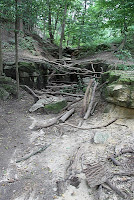Heavy equipment finished repairing a stormwater pipe leading from the park. The pipe had failed, causing a small sink hole in the street below the park. It's an illustration of how the old stormwater solutions don't always stay solved.
As we talked, Peter was salvaging roses removed from the berm. Peter had planned a volunteer work party to move the roses to another part of the park. But work on the pipe was so far ahead of schedule that the work party was canceled, and Peter was scrambling to save what roses he could.
Stormwater moves through the park in pipes.
But in case there's a big storm and surface overflow, this is where the stormwater goes back underground.
The berm has been mulched. Later, low flowering perennials will be established here.
Other recent accomplishments
 Peter received a $5000 grant from DNR to have an Urban Forestry Management Plan done. Every tree in the park has been marked with a blue tag and has it's own assessment sheet. There are 248 tags.
Peter received a $5000 grant from DNR to have an Urban Forestry Management Plan done. Every tree in the park has been marked with a blue tag and has it's own assessment sheet. There are 248 tags.Two trees are dominant in the park--black locust and hackberry. Jensen loved the black locust, with its lovely, fragrant flowers, and filtered light. But his regard for the tree conflicted with his concept of using native plants--and most students of Jensen consider the tree a mistake. The black locust is an invasive species, in contrast to our native honey locust. So the management plan calls for the eventual removal of the non-native black locusts--about 35% of the canopy.
Some of the black locusts--like this one--have already been cut. There's a plan to cut lumber from the tree and use the lumber in the park.
In the SE corner of the park, you can see orange flags where hackberry trees were removed. In their place were planted 16 species of native trees and shrubs. This is consistent with Jensen's plans for the park. He favored native plants for their aesthetic and wildlife value. Natives are also easier to maintain.
This work was done by grad and undergraduate students under Prof. Samuel Dennis, Jr., in the fall of 2009. Peter brought a bobcat, and showed the students how to use it. After the demo, they got a chance to actually operate the machine themselves.
Peter called it "A bobcat experience. First the demo--Bobcat 101. Then pulling out stumps--Bobcat 201. They also learned how to use chain saws. No one was killed, and a lot of plants got moved about."
You can see what a rich resource the park is--for the whole community.
Along the east slope of the park, white birches have been planted, along with a native chokecherry (Prunus virginiana, marked with blue ribbons).
Madison's foresters did some creative things with the stumps!
A model park
With the Jensen plan and this little park, the City sees a wonderful opportunity to try something new--to restore and manage a city park for just native species. With only about four acres, the park is a manageable size for this experiment.
Peter says "It's do-able--with the right resources and the City as a partner with the Dudgeon-Monroe Neighborhood Association. We're starting to plant musclewood (Carpinus caroliniana) and witch hazel. The lower end and along Glenwood St. (on the W side) will be our first showcase."
Margaret Nelson, a retired physician at Student Health Services, works with the Neighborhood Intervention Program for kids. Margaret Nelson came up with the idea to give kids a space of their own to care for along Glenwood St. They removed day lilies from the edge of the park and put in a bed of native perennials.
Plans call for extending the native perennials further up the street. Margaret has also planted some native flowers along the sidewalk bordering Glenway Street on the other side.
Glenwood Children's Park
Steep sides of the ravine, plus a little rocky gorge, together make a natural playground.
When small trees were removed, the trunks were saved for the children. Some hay bales were provided... a tipi !
 Like true artists-- they are constantly rearranging their handiwork. Now the poles become the entrance to a mine!
Like true artists-- they are constantly rearranging their handiwork. Now the poles become the entrance to a mine!One downside to kids running up and down is erosion.
A way will have to be found to accommodate both wild kids and wild plants.
Future work
Here's the head of the ravine, where stormwater emerges from under the SW Bikeway. The stonework is crumbling, and needs to be redone.
Building dry-laid stone structures--natural stone without mortar--is a lost art. Peter is looking into the possibility of using dry-laid stone here or elsewhere in the park.
# # #















